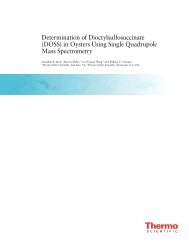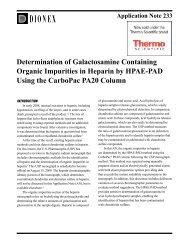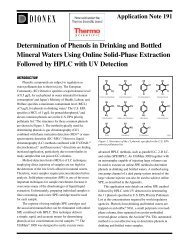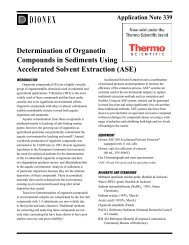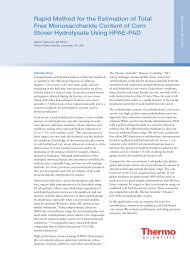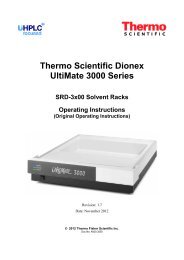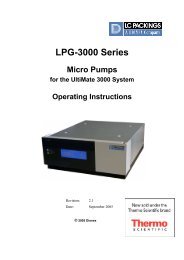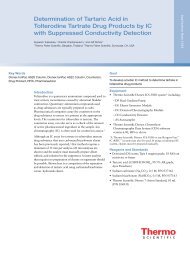Rapid Analysis of Aminothiols by UHPLC with Boron ... - Dionex
Rapid Analysis of Aminothiols by UHPLC with Boron ... - Dionex
Rapid Analysis of Aminothiols by UHPLC with Boron ... - Dionex
You also want an ePaper? Increase the reach of your titles
YUMPU automatically turns print PDFs into web optimized ePapers that Google loves.
<strong>Rapid</strong> <strong>Analysis</strong> <strong>of</strong> <strong>Aminothiols</strong> <strong>by</strong> <strong>UHPLC</strong> <strong>with</strong><br />
<strong>Boron</strong>-Doped Diamond Electrochemical Detection<br />
Bruce Bailey, Marc Plante, David Thomas, Qi Zhang and Ian Acworth<br />
Thermo Fisher Scientific, Chelmsford, MA, USA
Thermo Fisher Scientific, 22 Alpha Road, Chelmsford, M<br />
Overview<br />
Purpose: In order to obtain satisfactory information concerning aminothiols,<br />
disulfides, and thioethers from biological samples scientists require a sensitive<br />
approach that can measure key compounds, simultaneously. A simple, accurate<br />
and rapid <strong>UHPLC</strong> method was developed for the analysis <strong>of</strong> these compounds<br />
using isocratic liquid chromatography and an amperometric electrochemical cell<br />
<strong>with</strong> a boron-doped diamond (BDD) working electrode. This allowed the accurate<br />
quantification <strong>of</strong> analytes to low picogram (pg) sensitivity.<br />
Methods<br />
Analytical Conditions for Am<br />
Column:<br />
Pump Flow Rate:<br />
Mobile Phase:<br />
Methods: Direct analysis <strong>of</strong> aminothiols, disulfides and thioethers using <strong>UHPLC</strong><br />
chromatographic techniques <strong>with</strong> a robust electrochemical cell using a BDD<br />
electrode is described.<br />
Results: The method enables the rapid separation <strong>of</strong> various aminothiols,<br />
disulfides, and thioethers at low levels from whole blood <strong>with</strong>out significant matrix<br />
interferences.<br />
Introduction<br />
A number <strong>of</strong> biochemically important sulfur-containing compounds occur in vivo<br />
including: aminothiols (e.g., cysteine, glutathione [GSH], homocysteine), disulfides<br />
(e.g., cystine, glutathione disulfide [GSSG], homocystine), and thioethers (e.g.,<br />
methionine) as shown in Figure 1. These aminothiols plays numerous physiological<br />
roles. GSH is a major cellular antioxidant and a c<strong>of</strong>actor for glutathione peroxidase,<br />
an enzyme that detoxifies hydrogen peroxide and lipid hydroperoxides. The high<br />
ratio <strong>of</strong> GSH/GSSG keeps the cell in a reducing environment, essential for its<br />
survival. Decreases in this ratio are associated <strong>with</strong> cellular toxicity and numerous<br />
diseases including neurodegeneration (e.g., Parkinsonʼs disease). Cysteine is also<br />
a cellular antioxidant, serves as a precursor to glutathione and is <strong>of</strong>ten found in<br />
protein structures as a disulfide link. Methionine is an essential amino acid and<br />
serves as a methyl donor when incorporated into S-adenosylmethionine. Although a<br />
variety <strong>of</strong> HPLC techniques have been developed for the measurement <strong>of</strong> thiols,<br />
disulfides, and thioethers most <strong>of</strong> these exhibit technical issues. UV requires<br />
derivatization which can adversely affect the GSH/GSSG ratio, while some<br />
electrochemical approaches using glassy carbon electrodes suffer from electrode<br />
fouling and loss <strong>of</strong> response, and require routine maintenance. Although porous<br />
graphite working electrodes are more forgiving, they still need maintenance. <strong>Boron</strong>doped<br />
diamond (BDD) however, enable the direct measurement <strong>of</strong> these analytes<br />
<strong>with</strong>out electrode issues. 1,2 The rapid method presented herein is capable <strong>of</strong><br />
accurately determining several aminothiols simultaneously using <strong>UHPLC</strong><br />
chromatographic techniques <strong>with</strong> a BDD working electrode. Examples showing the<br />
analysis <strong>of</strong> GSH and GSSG from plasma samples using a simple “dilute and shoot”<br />
protocol are provided.<br />
Column Temperature:<br />
Post Column Temperature<br />
Injection Volume:<br />
Cell Potential:<br />
Filter Constant:<br />
Cell Clean:<br />
Cell Clean Potential:<br />
Cell Clean Duration:<br />
Sample Prep:<br />
FIGURE 2A. Thermo Scientifi<br />
FIGURE 2B. 6041RS ultra Am<br />
FIGURE 2C. Thermo Scientifi<br />
A<br />
A <strong>UHPLC</strong> approach was chosen as it provides several advantages over standard<br />
HPLC conditions including: shorter cycle times between samples; improved<br />
resolution, and sharper peaks. A sharper peak is important when measuring GSSG<br />
as it occurs at a low concentration and is one <strong>of</strong> the last peaks eluting in biological<br />
samples. The use <strong>of</strong> longer <strong>UHPLC</strong> columns provides better resolution between<br />
compounds, which is important when analyzing biological samples.<br />
FIGURE 1. Molecular structures <strong>of</strong> A) glutathione (GSH), B) glutathione disulfide<br />
(GSSG), C) methionine, and D) homocysteine<br />
A) GSH (reduced form)<br />
B) GSSG (oxidized form)<br />
C) Methionine D) Homocysteine<br />
The Thermo Scientific Di<br />
- SR-3000 Solvent Rack<br />
- DGP-3600RS Dual Gradi<br />
- WPS-3000TBPL Thermos<br />
- ECD-3000RS Electrochem<br />
<strong>with</strong> integrated temperatu<br />
- Chromeleon 6.80 SR12 C<br />
Results and Di<br />
An instrumental prerequisit<br />
inert (free from leachable tr<br />
using an electrochemical de<br />
biocompatible materials in t<br />
contribute to elevated back<br />
introduction <strong>of</strong> the ECD-300<br />
attached in series after the<br />
2 <strong>Rapid</strong> <strong>Analysis</strong> <strong>of</strong> <strong>Aminothiols</strong> <strong>by</strong> <strong>UHPLC</strong> <strong>with</strong> <strong>Boron</strong>-Doped Diamond Electrochemical Detection
c, 22 Alpha Road, Chelmsford, MA, USA<br />
n concerning aminothiols,<br />
scientists require a sensitive<br />
ltaneously. A simple, accurate<br />
nalysis <strong>of</strong> these compounds<br />
erometric electrochemical cell<br />
ode. This allowed the accurate<br />
sitivity.<br />
and thioethers using <strong>UHPLC</strong><br />
hemical cell using a BDD<br />
<strong>of</strong> various aminothiols,<br />
blood <strong>with</strong>out significant matrix<br />
ing compounds occur in vivo<br />
GSH], homocysteine), disulfides<br />
ystine), and thioethers (e.g.,<br />
ols plays numerous physiological<br />
factor for glutathione peroxidase,<br />
lipid hydroperoxides. The high<br />
vironment, essential for its<br />
h cellular toxicity and numerous<br />
sonʼs disease). Cysteine is also<br />
tathione and is <strong>of</strong>ten found in<br />
an essential amino acid and<br />
-adenosylmethionine. Although a<br />
for the measurement <strong>of</strong> thiols,<br />
hnical issues. UV requires<br />
/GSSG ratio, while some<br />
lectrodes suffer from electrode<br />
aintenance. Although porous<br />
y still need maintenance. <strong>Boron</strong>measurement<br />
<strong>of</strong> these analytes<br />
ented herein is capable <strong>of</strong><br />
neously using <strong>UHPLC</strong><br />
lectrode. Examples showing the<br />
using a simple “dilute and shoot”<br />
eral advantages over standard<br />
ween samples; improved<br />
portant when measuring GSSG<br />
e last peaks eluting in biological<br />
des better resolution between<br />
logical samples.<br />
GSH), B) glutathione disulfide<br />
G (oxidized form)<br />
ocysteine<br />
Methods<br />
Analytical Conditions for Aminothiol, Disulfide and Thioether <strong>Analysis</strong><br />
Column:<br />
Thermo Scientific Accucore RP-MS column<br />
2.6 μm, 2.1 × 150 mm<br />
Pump Flow Rate:<br />
0.500 mL/min<br />
Mobile Phase:<br />
0.1% pentafluoropropionic acid, 0.02% ammonium<br />
hydroxide, 2.5% acetonitrile, water<br />
Column Temperature: 50.0 °C<br />
Post Column Temperature 25.0 °C<br />
Injection Volume:<br />
2 µL standards; 4 µL samples<br />
Cell Potential:<br />
Thermo Scientific <strong>Dionex</strong> model 6041RS ultra<br />
Amperometric Analytical Cell <strong>with</strong> BDD electrode at<br />
+1600 mV<br />
Filter Constant:<br />
1.0 s<br />
Cell Clean:<br />
On<br />
Cell Clean Potential: 1900 mV<br />
Cell Clean Duration: 10.0 s<br />
Sample Prep:<br />
5–20 µL whole blood + 200 µL 0.4 N PCA, mix and<br />
spin for 10 minutes at 13,000 RPM. The clear<br />
supernatant was transferred into an autosampler vial<br />
and placed on the autosampler at 10 °C.<br />
FIGURE 2A. Thermo Scientific <strong>Dionex</strong> UltiMate 3000 Electrochemical detector<br />
FIGURE 2B. 6041RS ultra Amperometric Analytical Cell <strong>with</strong> BDD electrode<br />
FIGURE 2C. Thermo Scientific <strong>Dionex</strong> nanoViper fingertight capillaries<br />
A<br />
The Thermo Scientific <strong>Dionex</strong> UltiMate 3000 <strong>UHPLC</strong> system consists <strong>of</strong>:<br />
- SR-3000 Solvent Rack<br />
- DGP-3600RS Dual Gradient Pump<br />
- WPS-3000TBPL Thermostatted Analytical Autosampler<br />
- ECD-3000RS Electrochemical Detector<br />
<strong>with</strong> integrated temperature controlled column compartment<br />
- Chromeleon 6.80 SR12 Chromatography Data System s<strong>of</strong>tware<br />
Results and Discussion<br />
An instrumental prerequisite for trace analysis is that the HPLC system must be<br />
inert (free from leachable transition metals) in order to achieve optimal sensitivity<br />
using an electrochemical detector. The system shown above in Figure 2A uses<br />
biocompatible materials in the flow path to reduce the influence <strong>of</strong> metal that can<br />
contribute to elevated background currents at the electrochemical cell. The recent<br />
introduction <strong>of</strong> the ECD-3000RS detector enables multiple electrodes to be<br />
attached in series after the HPLC column.<br />
B<br />
C<br />
Use <strong>of</strong> the 6041RS amperome<br />
electrochemical capabilities <strong>of</strong><br />
oxidation <strong>of</strong> organic compound<br />
working electrode materials. Th<br />
voltammetric resolution <strong>of</strong> com<br />
fittings were employed to cope<br />
particles. These fingertight, virt<br />
operate at pressures up to 14,5<br />
tubing which can slip when usi<br />
tubing and are available in sma<br />
band spreading. Capillaries us<br />
connections made prior to the<br />
after the injector valve.<br />
FIGURE 3. Overlay <strong>of</strong> analytic<br />
3.0 µA<br />
2.8<br />
2.6<br />
2.4<br />
2.2<br />
2.0<br />
1.8<br />
1.6<br />
1.4<br />
1.2<br />
1.0<br />
0.8<br />
0.6<br />
0.4<br />
0.2<br />
-0.0<br />
CysGly<br />
GSH<br />
0.0 0.2 0.4 0.6 0.8 1.0 1.2 1.4 1.6 1.8<br />
The direct electrochemical dete<br />
doped diamond electrochemica<br />
potential used for this study (+1<br />
disulfide analytes. Advantages<br />
and method simplicity since no<br />
analysis the electrode surface<br />
+1900 mV. After a 1.5 minute r<br />
again stable and could be used<br />
method, the whole blood samp<br />
and then centrifuged. The clea<br />
autosampler vial and placed on<br />
rapid sample processing thus m<br />
thiols. <strong>Rapid</strong> <strong>UHPLC</strong> analysis a<br />
samples <strong>with</strong>in three minutes b<br />
place.<br />
For biological studies, the dete<br />
compounds such as GSH, GSS<br />
illustrates the overlay <strong>of</strong> calibra<br />
1–20 µg/mL. Peak resolution a<br />
The column used for this meth<br />
material which provides fast, h<br />
pressures. When operated at 0<br />
than 300 bar <strong>with</strong> the last comp<br />
in Figure 3.<br />
The calibration curves for amin<br />
linearity <strong>of</strong> response to differen<br />
coefficients ranging from R 2 = 0<br />
(Table 1) over the range <strong>of</strong> 1–2<br />
(%RSD) for the calibration curv<br />
in Table 1. The RSD values ran<br />
electrode provided good stabili<br />
Thermo Scientific Poster Note • PN70532_E 03/13S<br />
3
e and Thioether <strong>Analysis</strong><br />
fic Accucore RP-MS column<br />
50 mm<br />
ropropionic acid, 0.02% ammonium<br />
acetonitrile, water<br />
; 4 µL samples<br />
fic <strong>Dionex</strong> model 6041RS ultra<br />
nalytical Cell <strong>with</strong> BDD electrode at<br />
blood + 200 µL 0.4 N PCA, mix and<br />
tes at 13,000 RPM. The clear<br />
s transferred into an autosampler vial<br />
he autosampler at 10 °C.<br />
iMate 3000 Electrochemical detector<br />
tical Cell <strong>with</strong> BDD electrode<br />
oViper fingertight capillaries<br />
3000 <strong>UHPLC</strong> system consists <strong>of</strong>:<br />
utosampler<br />
mn compartment<br />
ata System s<strong>of</strong>tware<br />
is is that the HPLC system must be<br />
n order to achieve optimal sensitivity<br />
m shown above in Figure 2A uses<br />
duce the influence <strong>of</strong> metal that can<br />
t the electrochemical cell. The recent<br />
ables multiple electrodes to be<br />
Use <strong>of</strong> the 6041RS amperometric cell (Figure 2B) provides the unique<br />
electrochemical capabilities <strong>of</strong> the boron-doped diamond which enables the<br />
oxidation <strong>of</strong> organic compounds using higher electrode potentials than other<br />
working electrode materials. This platform provides both chromatographic and<br />
voltammetric resolution <strong>of</strong> compounds. The nanoViper (Figure 2C) fingertight<br />
fittings were employed to cope <strong>with</strong> the higher pressures due to smaller column<br />
particles. These fingertight, virtually zero-dead-volume (ZDV) capillaries can<br />
operate at pressures up to 14,500 psi and are much safer to use than PEEK<br />
tubing which can slip when using elevated pressures. They are made <strong>of</strong> PeekSil<br />
tubing and are available in small internal dimensions to minimize chromatographic<br />
band spreading. Capillaries used on this system were 150 micron ID for all<br />
connections made prior to the autosampler valve and 100 micron ID for those made<br />
after the injector valve.<br />
FIGURE 3. Overlay <strong>of</strong> analytical standards ranging from 1–20 µg/mL<br />
3.0<br />
µA<br />
2.8<br />
2.6<br />
2.4<br />
2.2<br />
2.0<br />
1.8<br />
1.6<br />
1.4<br />
1.2<br />
1.0<br />
0.8<br />
0.6<br />
0.4<br />
0.2<br />
CysGly<br />
GSH<br />
Methionine<br />
HCYS<br />
-0.0<br />
min<br />
0.0 0.2 0.4 0.6 0.8 1.0 1.2 1.4 1.6 1.8 2.0 2.2 2.4 2.6 2.8 3.0 3.2 3.4 3.6 3.8 4.0 4.2 4.4 4.6 4.8 5.0<br />
The direct electrochemical detection <strong>of</strong> aminothiol compounds only using a borondoped<br />
diamond electrochemical cell has been previously described. 1 The applied<br />
potential used for this study (+1600 mV) was sufficient to oxidize both thiol and<br />
disulfide analytes. Advantages <strong>of</strong> this approach include a stable electrode surface<br />
and method simplicity since no sample derivatization is required. After each<br />
analysis the electrode surface was regenerated <strong>by</strong> a 10 second clean cell pulse at<br />
+1900 mV. After a 1.5 minute re-equilibration at +1600 mV the electrode was once<br />
again stable and could be used for the analysis <strong>of</strong> the next sample. In the current<br />
method, the whole blood sample was added to the perchloric acid media, mixed<br />
and then centrifuged. The clear supernatant was then transferred into an<br />
autosampler vial and placed on the autosampler at 10 C. This approach enabled<br />
rapid sample processing thus minimizing issues related to the instability <strong>of</strong> the<br />
thiols. <strong>Rapid</strong> <strong>UHPLC</strong> analysis as shown in Figure 3 enables processing <strong>of</strong> these<br />
samples <strong>with</strong>in three minutes before any major chemical transformations take<br />
place.<br />
For biological studies, the determination <strong>of</strong> aminothiol content should include<br />
compounds such as GSH, GSSG, methionine, and homocysteine. Figure 3<br />
illustrates the overlay <strong>of</strong> calibration standards for these compounds ranging from<br />
1–20 µg/mL. Peak resolution and retention time uniformity were both excellent.<br />
The column used for this method was the Accucore RP-MS 2.6 micron solid-core<br />
material which provides fast, high resolution separations but <strong>with</strong> lower system<br />
pressures. When operated at 0.5 mL/min at 50.0 C the backpressure was less<br />
than 300 bar <strong>with</strong> the last compound (GSSG) eluting under 2.8 minutes as shown<br />
in Figure 3.<br />
The calibration curves for aminothiol standards are shown in Figure 4. Good<br />
linearity <strong>of</strong> response to different concentrations was obtained <strong>with</strong> correlation<br />
coefficients ranging from R 2 = 0.989–1.00 for the five compounds evaluated<br />
(Table 1) over the range <strong>of</strong> 1–20 µg/mL. The percent relative standard deviation<br />
(%RSD) for the calibration curves (five concentrations in triplicate) is also shown<br />
in Table 1. The RSD values ranged from 1.2% to 8.9%, indicating that the BDD<br />
electrode provided good stability during this study.<br />
GSSG<br />
20 ug/mL<br />
10 ug/mL<br />
5 ug/mL<br />
2 ug/mL<br />
1 ug/mL<br />
Response (µA)<br />
0.12<br />
0.10<br />
0.08<br />
0.06<br />
0.04<br />
0.02<br />
0.00<br />
-0.02<br />
FIGURE 4. Calibration cu<br />
1.6<br />
1.4<br />
1.2<br />
1<br />
0.8<br />
0.6<br />
0.4<br />
0.2<br />
0<br />
0 5<br />
CysGly<br />
Table 1. Regression data<br />
Poin<br />
Peak #<br />
CysGly 15<br />
GSH 15<br />
Meth 15<br />
HCYS 15<br />
GSSG 15<br />
Enhanced peak shape (na<br />
<strong>of</strong> the 6041RS cell <strong>with</strong> a B<br />
volume <strong>of</strong> only 50 nL contr<br />
the noise <strong>of</strong> the electroche<br />
illustrates that amounts les<br />
determined <strong>by</strong> this method<br />
shown in Table 2 and rang<br />
ratio <strong>of</strong> 5 are also shown in<br />
5 is also shown in this tabl<br />
LOD for GSSG is 175 pg o<br />
FIGURE 5. Sensitivity <strong>of</strong><br />
0.15<br />
µA<br />
CysGly<br />
GSH<br />
0.0 0.5 1.0 1.5<br />
Table 2. Signal-to-noise r<br />
Compound CysG<br />
S/N Ratio 37<br />
LOD (pg, S/N <strong>of</strong> 5) 54<br />
4 <strong>Rapid</strong> <strong>Analysis</strong> <strong>of</strong> <strong>Aminothiols</strong> <strong>by</strong> <strong>UHPLC</strong> <strong>with</strong> <strong>Boron</strong>-Doped Diamond Electrochemical Detection
ovides the unique<br />
ond which enables the<br />
de potentials than other<br />
oth chromatographic and<br />
r (Figure 2C) fingertight<br />
res due to smaller column<br />
e (ZDV) capillaries can<br />
safer to use than PEEK<br />
. They are made <strong>of</strong> PeekSil<br />
to minimize chromatographic<br />
e 150 micron ID for all<br />
100 micron ID for those made<br />
from 1–20 µg/mL<br />
Response (µA)<br />
FIGURE 4. Calibration curves for standards (1–20 µg/mL, n=3)<br />
1.6<br />
R² = 0.9986<br />
1.4<br />
1.2<br />
R² = 0.9997<br />
1<br />
R² = 0.9892<br />
0.8<br />
0.6<br />
R² = 0.9996<br />
0.4<br />
R² = 0.9998<br />
0.2<br />
0<br />
0 5 10 15 20 25<br />
Concentration (µg/mL)<br />
CysGly GSH Methionine HCys GSSG<br />
FIGURE 6. Overlay <strong>of</strong> chromatog<br />
whole blood (blue trace)<br />
2.00<br />
µA<br />
1.80<br />
1.60<br />
1.40<br />
1.20<br />
1.00<br />
0.80<br />
0.60<br />
0.40<br />
0.20<br />
-0.00<br />
-0.20<br />
CysGly<br />
GSH<br />
20 ug/mL<br />
10 ug/mL<br />
5 ug/mL<br />
2 ug/mL<br />
1 ug/mL<br />
min<br />
.2 3.4 3.6 3.8 4.0 4.2 4.4 4.6 4.8 5.0<br />
mpounds only using a boronusly<br />
described. 1 The applied<br />
nt to oxidize both thiol and<br />
de a stable electrode surface<br />
is required. After each<br />
10 second clean cell pulse at<br />
0 mV the electrode was once<br />
e next sample. In the current<br />
erchloric acid media, mixed<br />
n transferred into an<br />
0 C. This approach enabled<br />
ted to the instability <strong>of</strong> the<br />
nables processing <strong>of</strong> these<br />
ical transformations take<br />
l content should include<br />
omocysteine. Figure 3<br />
se compounds ranging from<br />
rmity were both excellent.<br />
P-MS 2.6 micron solid-core<br />
ons but <strong>with</strong> lower system<br />
the backpressure was less<br />
under 2.8 minutes as shown<br />
hown in Figure 4. Good<br />
btained <strong>with</strong> correlation<br />
compounds evaluated<br />
relative standard deviation<br />
s in triplicate) is also shown<br />
%, indicating that the BDD<br />
0.12<br />
0.10<br />
0.08<br />
0.06<br />
0.04<br />
0.02<br />
0.00<br />
-0.02<br />
Table 1. Regression data for standard calibration curves<br />
Peak #<br />
Points<br />
RSD.<br />
%<br />
Correlation<br />
Coefficient.<br />
Slope<br />
CysGly 15 8.9059 0.989 0.0481<br />
GSH 15 1.7446 1.00 0.0509<br />
Meth 15 3.4526 0.999 0.0736<br />
HCYS 15 1.9282 1.00 0.0268<br />
GSSG 15 1.2458 1.00 0.0170<br />
Enhanced peak shape (narrow peak width) in addition to improved design features<br />
<strong>of</strong> the 6041RS cell <strong>with</strong> a BDD electrode provides good sensitivity. The small cell<br />
volume <strong>of</strong> only 50 nL contributes to low background currents which helps minimize<br />
the noise <strong>of</strong> the electrochemical cell. The chromatogram shown in Figure 5<br />
illustrates that amounts less than 400 pg on column <strong>of</strong> each compound can be<br />
determined <strong>by</strong> this method. The signal-to-noise ratios (S/N) for this standard are<br />
shown in Table 2 and range from 7.2–37. The limit <strong>of</strong> detection (LOD) <strong>with</strong> a S/N<br />
ratio <strong>of</strong> 5 are also shown in this table. The limit <strong>of</strong> detection (LOD) <strong>with</strong> S/N ratio <strong>of</strong><br />
5 is also shown in this table. For GSH the LOD is approximately 67 pg, while the<br />
LOD for GSSG is 175 pg on column.<br />
FIGURE 5. Sensitivity <strong>of</strong> low level analytical standard (400 pg on column)<br />
0.15<br />
µA<br />
CysGly<br />
GSH<br />
Methionine<br />
HCYS<br />
0.2 ug/mL<br />
min<br />
0.0 0.5 1.0 1.5 2.0 2.5 3.0 3.5 4.0 4.5 5.0<br />
Table 2. Signal-to-noise ratio values calculated for 400 pg on column<br />
Compound CysGly GSH Methionine Hcys GSSG<br />
S/N Ratio 37.0 29.4 20.4 7.2 11.4<br />
LOD (pg, S/N <strong>of</strong> 5) 54 67 98 278 175<br />
GSSG<br />
0.00 0.25 0.50 0.75 1.00 1.25 1.50 1.75 2.0<br />
Table 3. Aminothiol levels (µM) o<br />
electrode<br />
CysGly GSH<br />
Level µM 55.9±13.0 1017<br />
Figure 6 shows an overlay <strong>of</strong> chrom<br />
and a sample <strong>of</strong> deproteinized who<br />
easily measured in small samples<br />
method described. The levels dete<br />
reported levels using other techniq<br />
below the assay LOD using these<br />
detect this compound <strong>by</strong> simply inc<br />
processed.<br />
Conclusions<br />
• The method for the analysis for th<br />
thioethers proved to be simple an<br />
measurement in deproteinized wh<br />
autoxidation were minimized <strong>by</strong> r<br />
• Although the analysis <strong>of</strong> aminothi<br />
the method could be easily adapt<br />
compounds in plasma and tissue<br />
• The levels <strong>of</strong> GSH and GSSG de<br />
using other techniques.<br />
References<br />
1. Bailey, B.A. et al. Direct determin<br />
levels using HPLC-ECD <strong>with</strong> a no<br />
electrode. Advanced Protocols in<br />
2011, 594, 327-339.<br />
2. Park, H.J. et al. Validation <strong>of</strong> high<br />
diamond detection for assessing<br />
2010, 407, 151-159.<br />
3. Raffa, M. et al. Decreased glutath<br />
activities in drug-naïve first-episo<br />
11, 124-131.<br />
© 2013 Thermo Fisher Scientific Inc. All rights<br />
trademark <strong>of</strong> SGE International Pty Ltd. All ot<br />
Inc. and its subsidiaries. This information is n<br />
manners that might infringe the intellectual pr<br />
Thermo Scientific Poster Note • PN70532_E 03/13S<br />
5
mL, n=3)<br />
R² = 0.9986<br />
FIGURE 6. Overlay <strong>of</strong> chromatograms <strong>of</strong> standard (black trace) vs.<br />
whole blood (blue trace)<br />
2.00<br />
µA<br />
1.80<br />
R² = 0.9997<br />
R² = 0.9892<br />
1.60<br />
1.40<br />
1.20<br />
es<br />
GSSG<br />
R² = 0.9996<br />
R² = 0.9998<br />
20 25<br />
elation Slope<br />
ficient.<br />
989 0.0481<br />
.00 0.0509<br />
999 0.0736<br />
.00 0.0268<br />
.00 0.0170<br />
improved design features<br />
ensitivity. The small cell<br />
nts which helps minimize<br />
shown in Figure 5<br />
ch compound can be<br />
N) for this standard are<br />
ction (LOD) <strong>with</strong> a S/N<br />
n (LOD) <strong>with</strong> S/N ratio <strong>of</strong><br />
imately 67 pg, while the<br />
(400 pg on column)<br />
1.00<br />
0.80<br />
0.60<br />
0.40<br />
0.20<br />
-0.00<br />
-0.20<br />
CysGly<br />
GSH<br />
Methionine<br />
Whole blood<br />
5 ug/mL mix<br />
0.00 0.25 0.50 0.75 1.00 1.25 1.50 1.75 2.00 2.25 2.50 2.75 3.00 3.25 3.50 3.75 4.00 4.25 4.50 4.75 5.00<br />
Table 3. Aminothiol levels (µM) observed in whole blood (n=3) using the BDD<br />
electrode<br />
CysGly GSH Methionine GSSG<br />
Level µM 55.9±13.0 1017.2±26.2 107.4±52.7 71.1±25.9<br />
Figure 6 shows an overlay <strong>of</strong> chromatograms for a standard mixture <strong>of</strong> aminothiols<br />
and a sample <strong>of</strong> deproteinized whole blood. The levels <strong>of</strong> GSH and GSSG was<br />
easily measured in small samples <strong>of</strong> whole blood (
www.thermoscientific.com/dionex<br />
©2013 Thermo Fisher Scientific Inc. All rights reserved. ISO is a trademark <strong>of</strong> the International Standards Organization.<br />
PEEK is a trademark <strong>of</strong> Victrex PLC. Peeksil is a trademark <strong>of</strong> SGE International Pty Ltd. All other trademarks are the property<br />
<strong>of</strong> Thermo Fisher Scientific Inc. and its subsidiaries. This information is presented as an example <strong>of</strong> the capabilities <strong>of</strong> Thermo<br />
Fisher Scientific Inc. products. It is not intended to encourage use <strong>of</strong> these products in any manners that might infringe the<br />
intellectual property rights <strong>of</strong> others. Specifications, terms and pricing are subject to change. Not all products are available in<br />
all countries. Please consult your local sales representative for details.<br />
Thermo Fisher Scientific, Sunnyvale, CA<br />
USA is ISO 9001:2008 Certified.<br />
Australia +61 3 9757 4486<br />
Austria +43 1 333 50 34 0<br />
Belgium +32 53 73 42 41<br />
Brazil +55 11 3731 5140<br />
China +852 2428 3282<br />
Denmark +45 70 23 62 60<br />
France +33 1 60 92 48 00<br />
Germany +49 6126 991 0<br />
India +91 22 2764 2735<br />
Italy +39 02 51 62 1267<br />
Japan +81 6 6885 1213<br />
Korea +82 2 3420 8600<br />
Netherlands +31 76 579 55 55<br />
Singapore +65 6289 1190<br />
Sweden +46 8 473 3380<br />
Switzerland +41 62 205 9966<br />
Taiwan +886 2 8751 6655<br />
UK/Ireland +44 1442 233555<br />
USA and Canada +847 295 7500<br />
PN70532_E 03/13S




